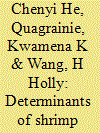| Srl | Item |
| 1 |
ID:
149767


|
|
|
| 2 |
ID:
121806


|
|
|
|
|
| Publication |
2013.
|
| Summary/Abstract |
Shrimp farmers in the USA are facing the situation of increased imports resulting in reduced market share, falling prices, and reduced profitability for their farm-raised shrimp. The study examined the determinants of shrimp imports from China, Vietnam, Thailand, and Indonesia using an augmented gravity model of international trade. The results reveal that US imports from the four exporting countries are significantly affected by the GDP of exporting countries, GDP of the USA, exchange rate, unit import value (proxy for import price) of shrimp, and tariff. Tariff policy has implications for the US shrimp industry.
|
|
|
|
|
|
|
|
|
|
|
|
|
|
|
|
| 3 |
ID:
100754


|
|
|
|
|
| Publication |
2010.
|
| Summary/Abstract |
Using spatial econometric techniques, this paper presents an empirical analysis of the growth performances of Chinese prefectures over 1991 to 2007 period. Based on the Solow growth theory with technology spillovers, a Spatial Durbin growth model recently developed is employed to capture the spatial externalities. We find strong evidence of positive spatial dependence between Chinese prefectures after 1991. Apart from the usual divergence conclusions, we find evidence for significant conditional convergence force when the spatial spillover effects are controlled. Our results also indicate the competition effect of capital accumulation and urbanization growth among neighboring regions. Moreover, spatial convergence clubs are detected and the spatial interactions and growth behavior varies.
|
|
|
|
|
|
|
|
|
|
|
|
|
|
|
|